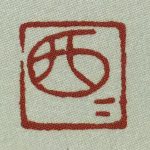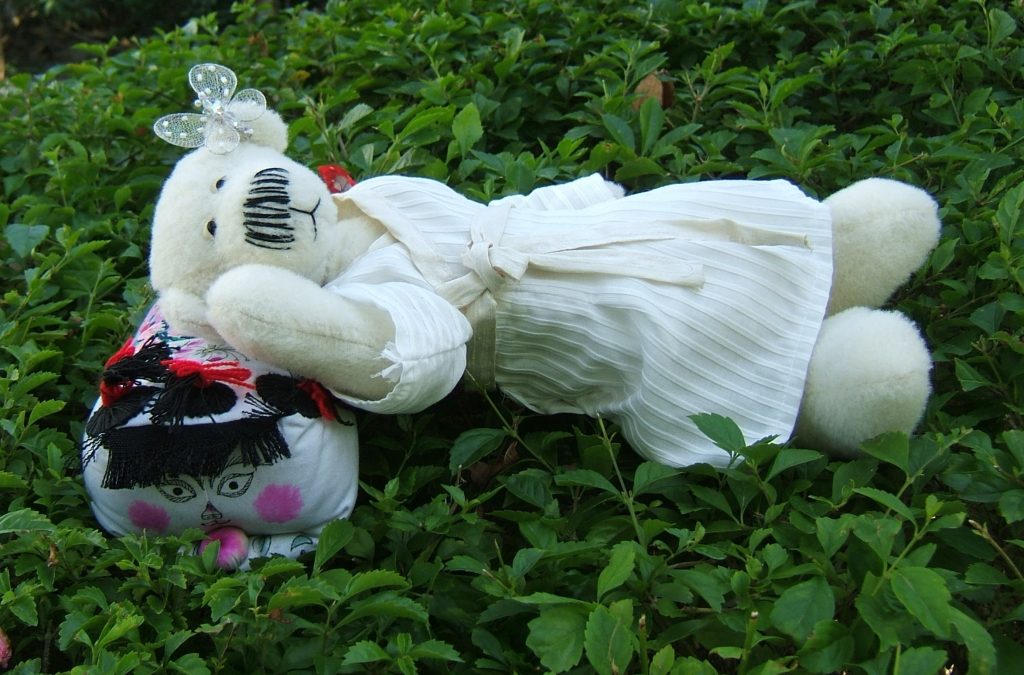In 1989, the Hong Kong writer Xi Xi 西西 was diagnosed with breast cancer. Post-operative treatment damaged the nerves in her right hand, but she taught herself to write with her left and, in 1992, published Elegy for a Breast 哀悼乳房 (adapted for the screen as 2 Become 1). Later on, in an effort to regain movement in her affected hand, Xi Xi focussed on handicrafts. Over the years, she crafted dolls houses, puppets and stuffed animals, and eventually teddy bears. Her bears started out within the familiar tradition of the Western teddy — the toy bears inspired by Theodore (Teddy) Roosevelt in the 1900s and Winnie-the-Pooh in the 1920s — but over time Xi Xi developed her own, uniquely Chinese breed.

The Teddy Bear Chronicles 縫熊志 appeared through Joint Publishing HK in 2009. It consists of short essays influenced by the biographical style, or 列傳, of Sima Qian 司馬遷 (206 BC-220 CE), the Grand Historian of the Han dynasty. Xi Xi matches her biographical sketches with images from her ursine pantheon of handmade teddies.
This Teddy Bear’s Picnic includes mythological figures such as the Queen Mother of the West 西天王母, as well as Hou Yi 后羿 and Chang’e 嫦娥, along with historical personalities like the Taoist thinker Zhuangzi 莊子, the disaffected courtier-turned-poet Qu Yuan 屈原, the historian Sima Qian himself, the calligrapher Wang Xizhi 王羲之, the recluse Tao Yuanming 陶淵明, as well as the mauruding emperor Genghis Khan 成吉思汗. Xi Xi also found inspiration in the heroes of the popular Ming-dynasty novel Water Margin 水滸傳. Some prominent figures from the West share the spotlight, too, including Julius Caesar and Cleopatra; there’s even a suave Lawrence of Arabia. All the teddies wear costumes designed and made by Xi Xi.
Xi Xi is one of those rare artists who has the genius to make the old new again. It is a talent that she has nurtured in (and that thas been nurtured by) Hong Kong.
The Teddy Bear Chronicles is an ecumenical fancy-dress ball; Xi Xi sent out all the invitations, she wrote the script and dressed the guests. It is with great pleasure that below we introduce our readers to ‘Zhuangzi’, a teddy bear tale inspired by the great philosopher who lived around the fourth century BCE, during the Warring States period.
Xi Xi is the pen name of Cheung Yin 張彥, one of Hong Kong’s most beloved and acclaimed writers. She says that the Chinese characters of her pen name, 西西, look to her like a girl playing a Chinese form of hopscotch in a skirt. Her creative work is a delicate admix of the naïve and the absurd. Regarded as a pioneer of experimental filmmaking and screenwriting in the 1960s, Xi Xi went on to publish two collections of poetry, seven novels, twenty-one short story and essay collections and one stand-alone novella. Her essays have also frequently appeared in the popular press, as have her translations.

Xi Xi is the second of five children born in 1938 to Cantonese parents in Shanghai. The family migrated to Hong Kong in 1950 shortly after the founding of the People’s Republic on the mainland. Following high school and graduate education, she worked as an English teacher at a government primary school. Living in the cultural and trading entrepôt of Hong Kong and comfortable in several languages, Xi Xi was exposed to world literature and culture from an early age and she cites the main influences on her work as being children’s writing, film and Latin American and European literature.
***
This introductory note is based on material provided by Christina Sanderson, translator of The Teddy Bear Chronicles. It also incorporates information from Jennifer Feeley’s introduction to Not Written Words 不是文字, a selection of Xi Xi’s poetry in translation.
We are grateful to Christina for sharing this new work with our readers, and to John Minford who introduced us all to Xi Xi’s panoply of bears. The translation of The Teddy Bear Chronicles will appear as a volume in a series under John’s editorship. That series is generously funded by the Hong Kong Arts Development Council.
The photographs of Xi Xi’s teddies are by Chan Kum-lok 陳錦樂 and Lum Kwok-wai 林國威.
We look forward to introducing more teddy bears from Xi Xi’s chronicles in the future.
— Geremie R. Barmé, Editor, China Heritage
Zhuangzi 莊子
Zhuangzi was a fascinating individual with more stories up his sleeve than anybody else in the world. Some of his stories are long, others are short; but they’re all interesting and superbly imaginative. They’re also full of paradoxes — to use a favourite expression of his (even though it’s become a terrible cliché). In one instance, a gigantic bird capable of flying ninety thousand li in one flap of the wing turns out to be the transformation of a miniscule fish. In another, a massive gourd that was hopeless as a water jug could well serve as a sailing boat. Then there’s that huge, useless tree, which delights in being considered useless. Since nobody wants it for anything, it can come to no harm. Why wouldn’t it be happy about that?
莊子真是世界上最多故事的妙人。他的故事大大小小,有趣,充滿想像,充滿,用他的詞匯雖然這詞匯已濫得有點肉麻:弔詭。例如有時是很大很大的鳥,一飛九萬里,可這大鳥是從一尾很小很小的魚變成的。有時是很大很大的葫蘆,可不要用來盛水,而是最好當遊船﹔有時呢是一棵沒用的大樹,你說它沒用,它可高興了,你就不會打它的主意,損害它,它豈不悠哉游哉。
Zhu Guangqian, who founded the study of aesthetics in modern China, wrote an essay discussing three ways to look at ancient pine trees. It’s interesting enough. But aeons before this, Zhuangzi had already introduced another, completely different point of view: that of the tree itself. Once we can imagine a tree with its own own point of view, then we won’t go around thinking ourselves better than trees, or imposing our will upon them. From then on, we will respect trees. Starting from a sense of respect for trees, we can go on to respect other things.
朱光潛以往寫過篇三種角度看一棵古松的文章,很有意思﹔不過三種角度都把樹木對象化,莊子老早告訴我們,其實還有另外一種角度﹕樹木自己的角度。如果想到還有這麼一個樹木本身的角度,你就不會看輕樹木,不會對樹木強加自己的主觀意志,從而尊重樹木。從尊重一棵樹木出發,你就會懂得尊重其他。
Zhuangzi is constantly teaching us how to see things differently: from the opposite angle; from the contrary point of view. The idea is to reveal how not to be stubborn, biased, or prejudiced. In one case, he asks: How can a summer-born bug whose life spans just a single season, ever hope to understand ice or snow? He goes on to explain why the summer bug has no way of understanding such things. It should be aware of its limitations, and accept the possibility of other points of view. It shouldn’t go around judging things related to other seasons from its own limited perspective, that of a summer bug. Humans perpetuate the error made by the summer-born bug, and have been doing so for more than two thousand years.
莊子總是教我們用不同的角度看物事,相反的角度,逆向的角度,不要偏執成見。試想想,生長一季的夏蟲,如何明白冰雪是什麼。這是夏蟲沒有辦法的事,但牠至少要知道自己的局限,其他角度的可能,不要死抱夏蟲之見去判斷另一個季節的物事。二千多年來,我們人類的社會,仍然犯著夏蟲的毛病。
They say that a certain monarch once offered Zhuangzi the post of Prime Minister. He refused. Now that is an earnest renouncement of fame and fortune. His stories were certainly not idle chit-chat. He practised what he preached.
據說某某國君想請他做宰相,他拒絕了,這是對名利真正的捨棄。他的故事,可不是說說就算。

Sometimes Zhuangzi himself becomes the protagonist of his stories. The most famous is about a dream he once dreamed. He dreams of a butterfly, then imagines himself as the butterfly; until he no longer knows whether he is Zhuangzi dreaming of a butterfly, or a butterfly dreaming of a man called Zhuangzi. It has to be the best dream in history. Since when did we stop having wonderful dreams like that? Since when did our dreams become nothing more than objects for psychopathology?
有時,莊子連自己也成為故事的主人翁,最著名的是他一次做夢,夢見蝴蝶,於是從蝴蝶設想,到頭來不知是莊周夢見蝴蝶,抑或是蝴蝶夢見莊周。這夢,真是人類最甜美的夢。什麼時候,我們失去了這種美夢呢?什麼時候,我們的夢,成為病態心理學分析的對象?
The Zhuangzi bear I’ve made is most likely dreaming of butterflies in his sleep, too. You’ll see he has a wawa pillow, with a doll’s face at either end. Where is he sleeping? Under a big tree? On the grass? Just as a butterfly would, he has perched himself on top of a hedge for a nap.
我縫的莊子在睡覺時夢見蝴蝶了吧。他枕的是「娃娃枕」,兩頭各有一張娃娃臉。他睡在哪裡?大樹下,草地上?原來他一如蝴蝶,睡在一叢樹籬的頂端。

